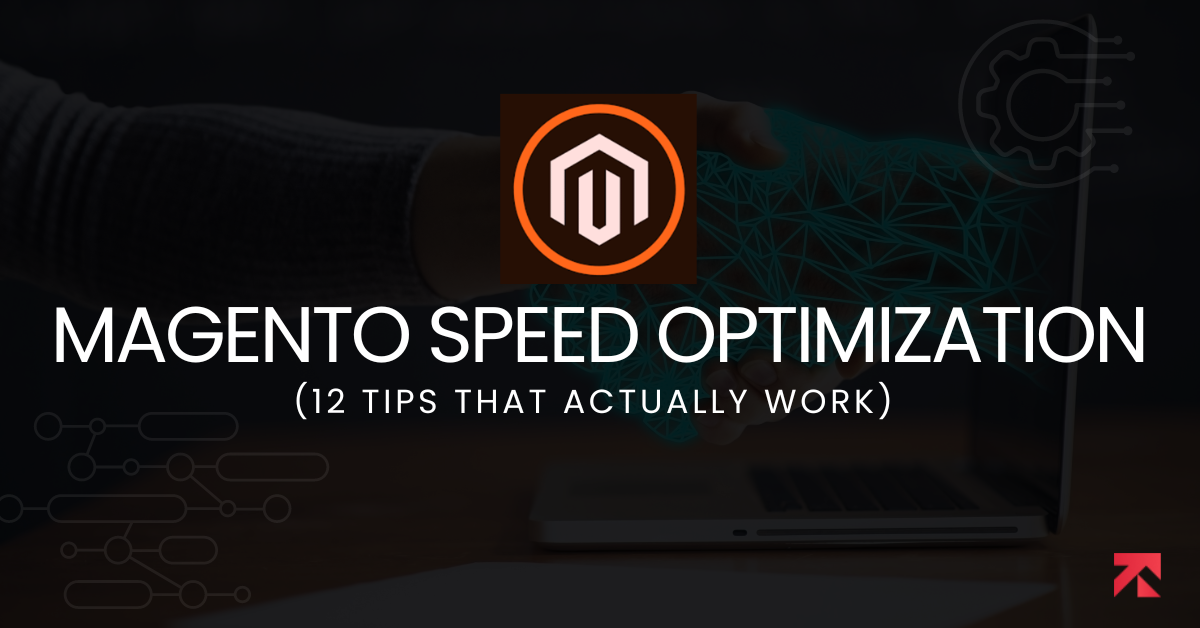admin

Table Of Contents
With Magento, performance optimization is everything and considered a crucial element to achieve the highest level of success. The details below emphasizes on Magento 2 speed optimization to make sure the platform works well for your store in terms of performance, customer expectations and business needs. But, let’s get the ball rolling by finding out the importance of Magento speed.
Table Of Contents
There are numerous ecommerce development platforms and more are being introduced as the industry booms but, Magento is the go-to choice for many retailers based on the many benefits it offers. A business’s foundation is built on critical factors. These include overall website speed, transitioning between pages, loading time, and user experience. These factors are crucial for both customers and retailers.
A research indicated that websites having more than three-second loading time experiences 50% abandonment and bounce rates. Additionally, Generation Z expects webpages to respond instantly. They want pages to load as quickly as they blink their eyes. As a result, businesses must prioritize speed and performance, particularly in eCommerce. There is no room for compromise in these areas.
On the contrary, search engine algorithms like that of Google take website speed as a core optimization and listing factor which means Adobe Commerce speed optimization for your business shouldn’t be below par or substandard. Just in-case it does, customers will land on your competitors site and prefer their offerings above yours.
Magento has advanced features that can help you achieve a faster and better performing website. This improved performance can lead to increased customer satisfaction, as well as more organic leads and conversions. By utilizing Magento’s capabilities, you can create a website that delivers a high-quality user experience and drives business growth. The eCommerce development platform considers page speed optimization at its priority and applies techniques like content caching, server-side CSS generation, JavaScript bundling and more.
Magento optimizes speed based on the customer’s device. This ensures that retailers can maximize conversions for all users. It can provide an excellent user experience, no matter the customer’s device. This way, every user can benefit from the same high-quality websites that are faster, securer and conversion optimized.
Indeed a leading eCommerce development platform, Magento 2, being a technology, has its flaws with slow loading pages, a lagging user interface, website crashes (infrequent though) being the only issues but there’s more to it than meets the eye. Such glitches may be the result of inaccurate hosting configuration, extremely complex coding and software bugs. Let’s explore these in detail:
A hosting plan that caters specifically to eCommerce websites should complement performance optimization. To support a system or website, it requires powerful hardware resources such as activated SSL certificates, RAM, high-speed SSD storage units, and multiple processors. Adding to it is your selection of a hosting provider which covers technical assistance as part of Magento optimization services and ensures optimal performance as well as system’s reliability.
Settings that configure Magento communication with third-party services, databases and caches are referred to as operation mode. To ensure optimal performance of your store, it’s important to use the accurate and appropriate operation mode. This action can prevent performance issues, regardless of the mode of operation. However, it’s essential to choose a mode that is in accordance with your corporate business.
Caching is a process that relieves server load from intensive activities and allows resources to allocate other tasks effectively. Improper caching or simply failing to do so can compromise the entire system’s performance which directly affects website loading and unresponsive user experience. With it, the hosting service provider also matters and ensures configuration from their end is proper. That said, managed scripts come with advanced configuration caching and support which eventually results in reduced issues.
Unnecessary features, overcomplicated coding and overloaded themes and extensions are sure to leave a user confused, compromise performance and even drag user experience. This is the reason you should be mindful of the extensions installed on your Magento store. No matter how many Magento 2 extensions you install lately, the only thing that matters is to consider each one’s use and the outcome you wish to gain for a better customer experience.
To keep your eCommerce website performance blazing-fast, we’ve prepared the best tips to speed up Magento 2. Check these out below:
Regularly updating your Magento can achieve a certain extent of speeding up your eCommerce website. You can see improvement when you upgrade to the latest version not just with Magento but with every technology, especially software.
Latest releases come out after every three-four months with improved features, bug fixes and speed optimization. Neglecting such updates means you’re compromising performance of your website which will later result in a poor performing and full of glitch website. Ensure faster, more streamlined workflow by updating your Magento to the latest version.
Magento is a sophisticated eCommerce development platform which needs certain system requirements to function at its best of which 2GB RAM and active SSL certificate are necessary prerequisites. Still, these requirements may vary depending on the website’s needs, functions you would like your eCommerce store to have and many other factors that add directly to the performance.
Beginners may prefer shared hosting, but as their business grows and attracts a lot of organic leads over time, they should ensure that their hosting service provider supports faster website loading, even if it requires a premium payment plan and dedicated/private hosting. If their demands are not being met, they can always choose to change their hosting service provider.
While your store can keep on running successfully with default Magento settings, keeping up with the latest trends is more important to offer exceptional and winning services that make you stand out from the rest. Having just the right extensions of Magento 2 can surely help you in achieving the desired outcome. Magento modules support the process, but they simply add more complex coding to your website, making it more complicated, eventually slowing down loading and minimizing performance.
Simply audit your extensions and look for the culprit or abuser that you need to optimize for speed and performance, or simply remove completely. For Magento speed optimization, always uninstall or remove unnecessary and unused extensions to make for a lighter, faster website.
Even your website themes can significantly slow performance of the store especially if there’re too many widgets, sliders, custom blocks and other features that might be unnecessary. As we speak, you can simply imagine the time it may take to load a page or website.
For both users and businesses, having either a faster or even a slower internet connection, a website with overloaded themes and unnecessary add-on features can be a nightmare that takes too much time to load. Before purchasing a theme, test it first with GooglePageSpeed and run it in demo mode to make sure you make the right decision.
eCommerce businesses these days try to wow their customers with glitzy themes, cutting-edge designs and an abundance of fonts. While the approach isn’t at all wrong or illegal in any way, it won’t work if the website fails to load or is extremely slow.
Then there are times when you may apply custom fonts in the header section of the page configuration and eventually experience dull performance. For Magento 2 speed optimization, experts would recommend deleting unused and unnecessary fonts and the same is suggested by GooglePageSpeed.
When a visitor lands on a website, they expect all of the page content to load altogether but, there are many different images varying in size that may take either less or more time to load. All of it eventually leads to a slow performing website or pixelated page that a user would immediately abandon.
In order to speed up Magento 2, optimizing images is necessary and the best strategy to do it is through lazy loading which works in a way that images load gradually as a visitor scrolls through the rest of the page. Lazy loading loads priority images and graphical representations first instead of compromising speed by loading all at once.
The end result is better customer experience, faster loading and a lesser bounce rate.
Images can take up a lot of space on your server. However, there are several options available for optimizing Magento speed beyond just using lazy loading. One such option is to use WebP images. Developed by Google, WebP images are supported by all browsers and can reduce file size by up to 35% without sacrificing quality. By implementing WebP images, you can improve your website’s speed and performance.
WebP technology is in its maturing phase whereas Magento doesn’t allow adding images already in the format to the platform. You can instead go for Magento 2 WebP Images extension to convert images either manually or automatically.
Magento 1 and 2 worked really well with flat catalogs due to lesser data consolidation and SQL queries, but users complained about performance degradations and various indexing issues. Therefore, they prefer turning-off flat catalogs.
JS bundling refers to grouping multiple JS files into bundles and eventually reducing the volume of HTTP requests. When you try to ease the server’s load, you might not improve the speed of your Magento website. The reason is that the browser won’t load the entire webpage until it downloads all the JS bundles. Additionally, whenever a browser requests a new page, Magento must load the JS bundles from the start. This can make the process painfully slow. The only way here to ensure Adobe Commerce speed optimization is to disable JS bundling.
Magento experts recommend using advanced JS bundling to improve performance. This method has multiple benefits. Firstly, it reduces the total number of HTTP requests. Secondly, it decreases the size of JS files. Finally, it eliminates the need to load all the bundles every time a browser request is made. By doing these things, the method helps improve website performance and user experience.
In fact, every page requires a certain JS dependency, but loading all the bundles is unnecessary. Instead, only the required ones should be loaded. To enable advanced JS bundling, you’ll have to define the bundles by page type that accounts for CMS pages, category, checkout and products.
The website may need to perform deeper configurations and restructure its modules for Magento 2 speed optimization, despite the fact that it loads only selected bundles for a single page.
Web applications that rely heavily on large volumes of dynamic content can benefit from using Varnish cache. It is an open-source and high-performing web accelerator that functions as a CDN or Content Delivery Network. With Varnish cache, a Magento environment can work flawlessly. Moreover, it is easy to configure, install and use, making it a useful tool for any web application. Static content like stylesheets, images and such loads faster with Varnish Cache, thus improving overall website performance. Caching dynamically generated pages is another capability which further helps in optimizing Magento 2 speed.
Slow website loading caused by CSS, HTML, and JS files can be a problem for both customers and retailers. To optimize website speed, you can use deferred JS loading. This approach allows you to execute the script file after page parsing, resulting in a faster Magento website.
Running a successful Magento-based eCommerce website is not impossible. However, it requires preparation and taking precautionary steps for Magento 2 speed optimization.
Table Of Contents

